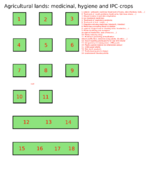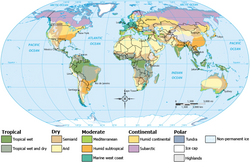m (-cat) |
|||
| (34 intermediate revisions by 6 users not shown) | |||
| Line 1: | Line 1: | ||
'''Appropriate health care manual''' refers to a manual regarding health care which is designed with special consideration to the environmental, ethical, cultural, social and economical aspects of the community it is intended for. In practice, appropiate health care can be set up using a mix of [http://en.wikipedia.org/wiki/Isolation_%28health_care%29 | '''Appropriate health care manual (AHCM)''' refers to a manual regarding health care which is designed with special consideration to the environmental, ethical, cultural, social and economical aspects of the community it is intended for. In practice, appropiate health care can be set up using a mix of [[genetic disease immunity]], [http://en.wikipedia.org/wiki/Isolation_%28health_care%29 isolation], [[vaccination]], [[phytotherapy]] and [[surgery]]. Phytotherapy can be used to treat smaller health problems and common diseases, while surgery can be used to treat serious injuries. | ||
==Set up== | ==Set up== | ||
[[File:Medicinal_and_hygiene_crops.png|thumb|right|150px|An appropriate herbal garden for a village]] | |||
Before being able to determine the cause of the disease or malady, accurate diagnosis is required. This may be done manually (through observation, inquiries) and by specialised tools. For this, villagers can be trained and can then monitor other villagers for maladies. Trained villagers have shown to be able to eliminate 80% of the health problems in other projects. Small (low-cost) hospitals - based on the model of the Jamkhed hospital – can remedy another 15%, while only 5% will need to go to a larger (more expensive) hospitals. | Before being able to determine the cause of the disease or malady, accurate diagnosis is required. This may be done manually (through observation, inquiries) and by specialised tools. For this, villagers can be trained and can then monitor other villagers for maladies. Trained villagers have shown to be able to eliminate 80% of the health problems in other projects. Small (low-cost) hospitals - based on the model of the Jamkhed hospital – can remedy another 15%, while only 5% will need to go to a larger (more expensive) hospitals. | ||
==Isolation== | ==Isolation== | ||
{{Main|Appropriate_health_care_manual_3}} | |||
Another method is simply to avoid any possible contact with pathogens. This is done trough correct sanitation systems, reducing interaction with anyone that has gotten a malady, wearing sufficient clothing in areas when pathogen carrying insects are known to sting (eg mosquito's carrying malaria, tse tse fly, ...). Also, [[disease-repelling plants|disease-repelling plants/sprays] are a form of isolation. The latter can eg be used by means of electric vaporisers or [[Bronchial kettle|flame-based vaporisers]] or dry herb heaters. The substances however need to be spread in each room, ie by placing one unit in each room, or via a HVAC duct. | |||
==Vaccination== | ==Vaccination== | ||
[http://en.wikipedia.org/wiki/Vaccination#Types_of_vaccinations Vaccination] is another important issue in appropriate health care. | [http://en.wikipedia.org/wiki/Vaccination#Types_of_vaccinations Vaccination] is another important issue in appropriate health care. Vaccination falls within 2 categories: Fundamental vaccinations and Repeating vaccinations. More information is available at [[Appropriate health care manual 3]] | ||
==Phytotherapy== | ==Phytotherapy== | ||
{{Main|Phytotherapy}} | |||
[[Image:Köppen climate classification.png|thumb|right|250px]] | [[Image:Köppen climate classification.png|thumb|right|250px]] | ||
<!-- I will expand this section when I gain assistance from a qualified phytotherapist. The herbs must btw be listed in each correct climate division of the Köppen climate classification --> | <!-- I will expand this section when I gain assistance from a qualified phytotherapist. The herbs must btw be listed in each correct climate division of the Köppen climate classification. Herb types are also still under revision, but I think the grouping is pretty correct nevertheless --> | ||
[ | [http://en.wikipedia.org/wiki/Herbalism#Routes_of_administration Herbalist medicines] can be taken as tinctures, tisanes, decoctions, ... . They can be freely made at home and are [[Phytotherapy|almost as effective]] as their [[Chemical medicine|chemical counterparts]]. A previous program that made use of herbal medicine was the [[Barefoot doctor]] program. | ||
* Exterior antiseptic medicine (treatment of burns, skin infections, boils, ...) | * Exterior antiseptic medicine (treatment of burns, skin infections, boils, ...) | ||
| Line 19: | Line 22: | ||
* Wound treatment and skin rehydration | * Wound treatment and skin rehydration | ||
* Ear treatment medicines | * Ear treatment medicines | ||
* Treatment of respiratory problems | * Treatment of respiratory problems | ||
* Treatment of fever (colds, ...) | * Treatment of fever (colds, ...) | ||
* Digestion relaxing medicines (stomach, intestins) | * Digestion relaxing medicines (stomach, intestins) | ||
* Medicines promoting blood circulation (against clogged and or showing veins, headaches, ...) | * Medicines promoting blood circulation (against clogged and or showing veins, headaches, ...) | ||
* Plants hindering pain receptors (eg against headaches, pain of wounds, ...) | * Plants hindering pain receptors (eg against headaches, pain of wounds, ...) | ||
* Plants inducing sleep | * Plants inducing sleep | ||
* Medicines promoting detoxification (blood purification, sweat inducing plants, diuretics, ...) | * Medicines promoting detoxification (blood purification, sweat inducing plants, diuretics, ...) | ||
The exact medicinal herb best used per group, depends on the location on earth. The herb needs to be chosen based on the [http://en.wikipedia.org/wiki/Climate Köppen climate]. | The exact medicinal herb best used per group, depends on the location on earth. The herb needs to be chosen based on the [http://en.wikipedia.org/wiki/Climate Köppen climate]. Also, if non-indiginous herbs are used, precautions need to be taken to prevent the spread of the plant into the environment. This could eg be done by using plants that no longer produce fertile seed. The size of the herb plantations can be kept small by constant harvesting and processing of the plants (eg into eg tinctures, ... which keep indefinitly). | ||
==Notes== | ==Notes== | ||
| Line 38: | Line 39: | ||
==Surgery== | ==Surgery== | ||
Surgery can be performed in small (low-cost) hospitals based on the model of the Jamkhed hospital. | Surgery can be performed in small (low-cost) hospitals based on the model of the [[Jamkhed]] hospital.[http://www.jamkhed.org/] | ||
==Advantages== | ==Advantages== | ||
| Line 47: | Line 48: | ||
==See also== | ==See also== | ||
<!--At wikipedia, there was also an article with common medicine hospitals should have; can't find it now, but needs adding later --> | <!--At wikipedia, there was also an article with common medicine hospitals should have; can't find it now, but needs adding later --> | ||
* [[Global Health Council]] | * [[Global Health Council]] | ||
* [[Women Health Volunteers]] | * [[Women Health Volunteers]] | ||
* [[Comprehensive Rural Health Project]]<ref>[http://ngm.nationalgeographic.com/2008/12/community-doctors/follow-up-text NGM Necessary angels]</ref> | |||
* [http://en.wikipedia.org/wiki/Epidemic#Factors_stimulating_new_epidemics Factors stimulating new epidemics] | |||
[[ | ==References== | ||
{{reflist}} | |||
== Interwiki links == | |||
* [[Wikipedia:Tropical disease]] | |||
* [[Wikipedia:Neglected diseases]] | |||
Revision as of 03:03, 1 November 2015
Appropriate health care manual (AHCM) refers to a manual regarding health care which is designed with special consideration to the environmental, ethical, cultural, social and economical aspects of the community it is intended for. In practice, appropiate health care can be set up using a mix of genetic disease immunity, isolation, vaccination, phytotherapy and surgery. Phytotherapy can be used to treat smaller health problems and common diseases, while surgery can be used to treat serious injuries.
Set up

Before being able to determine the cause of the disease or malady, accurate diagnosis is required. This may be done manually (through observation, inquiries) and by specialised tools. For this, villagers can be trained and can then monitor other villagers for maladies. Trained villagers have shown to be able to eliminate 80% of the health problems in other projects. Small (low-cost) hospitals - based on the model of the Jamkhed hospital – can remedy another 15%, while only 5% will need to go to a larger (more expensive) hospitals.
Isolation
Another method is simply to avoid any possible contact with pathogens. This is done trough correct sanitation systems, reducing interaction with anyone that has gotten a malady, wearing sufficient clothing in areas when pathogen carrying insects are known to sting (eg mosquito's carrying malaria, tse tse fly, ...). Also, [[disease-repelling plants|disease-repelling plants/sprays] are a form of isolation. The latter can eg be used by means of electric vaporisers or flame-based vaporisers or dry herb heaters. The substances however need to be spread in each room, ie by placing one unit in each room, or via a HVAC duct.
Vaccination
Vaccination is another important issue in appropriate health care. Vaccination falls within 2 categories: Fundamental vaccinations and Repeating vaccinations. More information is available at Appropriate health care manual 3
Phytotherapy

Herbalist medicines can be taken as tinctures, tisanes, decoctions, ... . They can be freely made at home and are almost as effective as their chemical counterparts. A previous program that made use of herbal medicine was the Barefoot doctor program.
- Exterior antiseptic medicine (treatment of burns, skin infections, boils, ...)
- Treatment of mouth problems (tooth ache, Aphthous ulcers, ...)
- Wound treatment and skin rehydration
- Ear treatment medicines
- Treatment of respiratory problems
- Treatment of fever (colds, ...)
- Digestion relaxing medicines (stomach, intestins)
- Medicines promoting blood circulation (against clogged and or showing veins, headaches, ...)
- Plants hindering pain receptors (eg against headaches, pain of wounds, ...)
- Plants inducing sleep
- Medicines promoting detoxification (blood purification, sweat inducing plants, diuretics, ...)
The exact medicinal herb best used per group, depends on the location on earth. The herb needs to be chosen based on the Köppen climate. Also, if non-indiginous herbs are used, precautions need to be taken to prevent the spread of the plant into the environment. This could eg be done by using plants that no longer produce fertile seed. The size of the herb plantations can be kept small by constant harvesting and processing of the plants (eg into eg tinctures, ... which keep indefinitly).
Notes
Regarding the herb groups Note that wound treatment is on a different section than the treatment of skin infections, ... this is because the first is a oil/creamish substance (prone to attracting bacteria/infections) and the second is desinfectant alone (not prone to attracting bacteria but with slower skin regeneration properties). Respiration and fever may be combined but most plants work either on 1 of the 2, so perhaps this is best left as is. Sterilisation can be done by smoking the body with Erythrophleum chlorostachyum, or by consuming plant substance of cymbidium madidum, petalostigma pubescens, Eucalyptus gamophylla. Headaches may be aleviated by 2 types of medicine, one working on the root cause and another simply disabling the pain receptors. Some references need to be found first, I made division based on the book "Bush food:Aboriginal food and herbal medicine by Jennifer Isaacs", and modified it based on own experiences/knowledge The plant examples can be placed in section as examples, full List of plants used as medicine article need to be modified too.
Surgery
Surgery can be performed in small (low-cost) hospitals based on the model of the Jamkhed hospital.[1]
Advantages
Compared to the use of professionally schooled doctors, this set-up is far less costly and has proven to be most appropriate.[1] Also, in the developing world, most doctors tend to leave to first world countries, thus meaning that in most developing countries, no doctors are still present; hereby making the hiring of alternative employees a more suitable option.
Also, as a great deal of medicine can be simply extracted from herbs, there is a great ecological advantage aswell, as no chemcial drugs no longer need to be made.
See also
- Global Health Council
- Women Health Volunteers
- Comprehensive Rural Health Project[2]
- Factors stimulating new epidemics
References